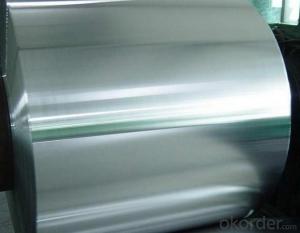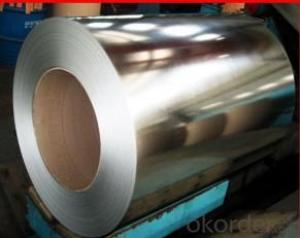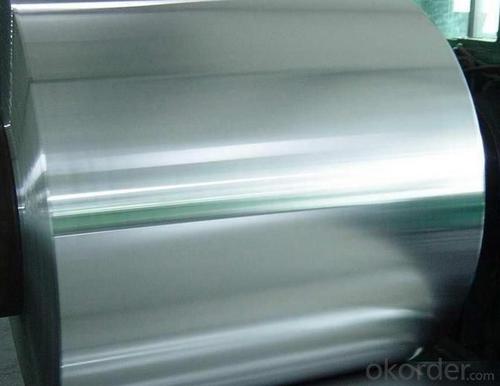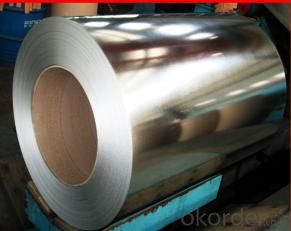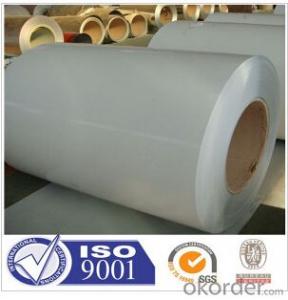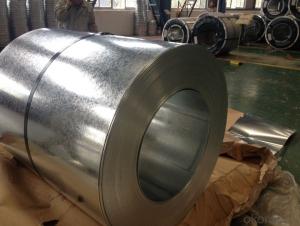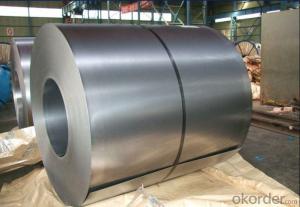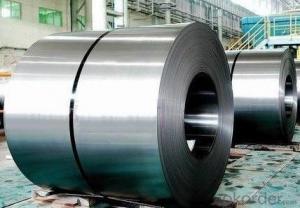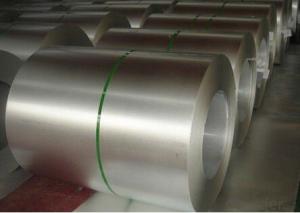Hot Dipped Galvanized Steel Coil for Constructions
- Loading Port:
- Shanghai
- Payment Terms:
- TT OR LC
- Min Order Qty:
- 30 m.t.
- Supply Capability:
- 10000 m.t./month
OKorder Service Pledge
OKorder Financial Service
You Might Also Like
Basic Info.
Model NO.:GT00818
Surface Treatment:Galvanized
Additional Info.
Packing:At buyer′s requirement
Standard:GB,JIS,ASTM
Origin:CHINA
HS Code:72123000
Production Capacity:50,000 mt/year
Product Description
Commodity: Hot dipped galvanized steel coil
Size: Thickness: 0.20mm to 1.2mm; Width: 500mm to 820mm
Surface finish: Regular spangle; Small spangle
Surface treatment: Chromated passivation
Zinc coating: Z08, Z12, Z18
Packing: Mill's standard packing for exporting
Usage: used in the industries such as construction ,cold rolling forming and electro mechanics manufacturing, household electric appliance manufacturing and etc
Standard adopted: GB/T2518-1998;Also we supply such steel strips according to JIS,ASTM standard to meet users'requirements.
Steel grade: Q195,Q195L,SPCC(Other material require agreement )
Equivalent standard: JIS G3302 1998 or ASTM A653M/A924M 1998
Price Terms: FOB, CIF Term
Payment Terms: T/T, L/C at sight
Delivery: 15 days after receiving your valid L/C/down payment
- Q: I was looking at my Great-Grandfather's immigration form from when he immigrated from Scotland and he listed his occupation as a steel dresser. What does a steel dresser do?
- I'm not sure, but it could be like and engineer working in steel design or steel polisher. I checked Wikipedia and Yahoo but found nothing. It may be a description of something only in Scotland. Sorry
- Q: How are steel coils priced in the market?
- Steel coils are typically priced in the market based on factors such as the current demand and supply dynamics, the quality and grade of the steel, the production and transportation costs, and any additional charges or taxes. The pricing can also be influenced by global economic trends, trade policies, and currency fluctuations.
- Q: Ok, lately I've been taking to making things out of stainless steel chain mallie rings. The problem is that when i make a bracelet or something, the area around the fastener always looks pretty bad. I'm thinking to have a friend who also does chain mallie finish the weave all the way around. This would make it look good but make it impossible to remove.Are there any long term problems with stainless steel on skin? I know some metals will change the color of the skin or make the skin absorb some of the metal. Is this something to worry about with stainless steel?
- Stainless steel contains both nickel and chromium. These two alloys are responsible for most of contact dermatitis in people. Some of my co-workers making steel had such bad reactions to chromium that they had to quit their jobs. Their skin was always inflamed. People don't react to finished stainless steel the same way because the alloys are bonded tightly in the heat treating process. But if you are grinding it and getting the dust on your skin, you could get a contact dermatitis if you are sensitive. I don't think it would absorb into your blood stream or do any long term damage to your skin. If you do get a reaction, you would have to cease your exposure or in a worse case scenario risk getting a body wide reaction like my coworkers. I would not worry about any exposure making rings out of stainless steel. After all, stainless steel is used in sugical implants and most people are fine.
- Q: hi to every one I need to konw moer about steel and iron industry (process) thank you in advance for your intresting
- Primary Steel Making first Iron ore Coke Lime stone are mined and then took to the steel plant and put in the top off a blast furnace and sinks down to the bottom off the blast furnace and turns into molten iron. Once this process has been done it is then transferred to a BOS (Basic Oxygen Steel Making) this is then poured from a ladle into the BOS and a Lance is inserted into the BOS and pure oxygen is blown into the BOS for about 30 min and turns into steel.
- Q: What are the environmental impacts of producing steel coils?
- The production of steel coils has several environmental impacts. Firstly, it involves the extraction of iron ore, which requires mining activities. These mining operations can lead to deforestation, habitat destruction, and soil erosion. Additionally, the extraction and processing of iron ore require large amounts of energy, contributing to greenhouse gas emissions and air pollution. Furthermore, the production of steel coils involves several stages, such as smelting and refining, which are energy-intensive and emit significant amounts of carbon dioxide, sulfur dioxide, and nitrogen oxides. These emissions contribute to air pollution, acid rain, and climate change. Water consumption is another notable environmental impact. Steel production requires large volumes of water for cooling and processing purposes. This high water demand can strain local water resources and potentially lead to water scarcity or pollution if not managed properly. Moreover, the steel industry generates substantial amounts of waste and by-products, such as slag, dust, and sludge. Proper disposal and treatment of these waste materials are crucial to prevent soil and water contamination. Lastly, transportation plays a role in the environmental impact of steel coil production. The transportation of raw materials and finished products can contribute to carbon emissions and air pollution, especially if long distances are involved. To mitigate these environmental impacts, various measures can be taken. Implementing more efficient production processes, such as recycling and using renewable energy sources, can reduce energy consumption and emissions. Additionally, improving waste management practices, investing in water conservation technologies, and optimizing transportation logistics can help minimize the environmental footprint of steel coil production.
- Q: How are steel coils used in the manufacturing of seat structures?
- Steel coils are used in the manufacturing of seat structures as they provide strength, durability, and stability to the seats. These coils are typically used in the construction of seat springs, which offer support and comfort to the occupants. The steel coils are carefully designed and placed within the seat structure to ensure proper weight distribution and to withstand the pressure exerted on the seats during usage.
- Q: How are steel coils used in the manufacturing of intake manifolds?
- Steel coils are typically used in the manufacturing of intake manifolds as the primary material for forming the manifold's structure. These coils are shaped and cut into specific dimensions to create the necessary components, such as runners and plenums, which help regulate the flow of air and fuel mixture into the engine. The steel coils are often subjected to additional processes, including welding, machining, and surface treatments, to ensure the final intake manifold meets the required specifications and performance standards.
- Q: What are the applications of steel coils in automotive manufacturing?
- Steel coils have various applications in automotive manufacturing. They are used primarily for the production of car bodies, as well as for other components such as doors, hoods, fenders, and trunk lids. Steel coils provide high strength, durability, and formability, making them suitable for creating robust and safe vehicles. Additionally, they offer excellent resistance to corrosion and can be easily molded into complex shapes, ensuring the desired design aesthetics and functionality.
- Q: I just bought a dpms ar15 and it says if I shoot steel cases (laquer coated) or foreign ammo it voids the warranty. But before I knew this I bought 200 rounds of Russian steel cased anmo. Think I should just shoot there two hundred and not buy anymore? Some people say all they shoot is steel cased ammo and have no problemAny advice is appreciated
- I would probably buy a box of 20 brass cased ones and shoot them first to see that the gun works if you really believe that steel cased/foreign ammo voids the warranty. That way you will know that the rifle is functional from the factory. My son has a Rem 700 SPS Varmint that has only fired handloads and there are a couple of other rifles that have never had a factory round in them and the manufacturers claim that hand loads void warranties too.
- Q: What are the trends and developments in the steel coil industry?
- The steel coil industry has witnessed several trends and developments in recent years. These changes have been driven by various factors, including technological advancements, shifts in demand and supply dynamics, and environmental concerns. One significant trend in the steel coil industry is the increasing use of advanced technologies in production processes. Automation and robotics have revolutionized steel coil manufacturing, leading to improved efficiency and quality control. These technologies have also enabled the industry to meet the growing demand for customized steel coils, as they allow for faster and more precise production. Another trend in the industry is the shift towards lightweight and high-strength steel coils. With the rising need for fuel-efficient vehicles, manufacturers are looking for lighter materials that maintain strength and durability. Steel coil producers are developing innovative products that meet these requirements, such as advanced high-strength steels and ultra-high-strength steels. These materials offer improved performance while reducing the weight of the final product. Environmental concerns have also spurred developments in the steel coil industry. There is a growing demand for sustainable and eco-friendly steel coils, which has led to the adoption of greener manufacturing processes. Steel coil manufacturers are increasingly utilizing recycled materials and implementing energy-efficient technologies to reduce carbon emissions and waste generation. Additionally, there is a focus on improving the recyclability of steel coils to minimize the environmental impact throughout their lifecycle. Furthermore, the steel coil industry is witnessing a shift in demand and supply dynamics. Emerging economies, particularly in Asia, are driving the demand for steel coils due to rapid industrialization and urbanization. This has led to increased investments in production capacity in these regions. On the other hand, developed economies are experiencing a trend towards consolidation and specialization, with some companies focusing on niche markets or specific steel coil applications. Overall, the steel coil industry is undergoing significant transformations driven by technological advancements, changing demand patterns, and environmental concerns. These trends and developments are shaping the landscape of the industry, making it more efficient, sustainable, and adaptable to evolving market needs.
Send your message to us
Hot Dipped Galvanized Steel Coil for Constructions
- Loading Port:
- Shanghai
- Payment Terms:
- TT OR LC
- Min Order Qty:
- 30 m.t.
- Supply Capability:
- 10000 m.t./month
OKorder Service Pledge
OKorder Financial Service
Similar products
Hot products
Hot Searches
Related keywords
